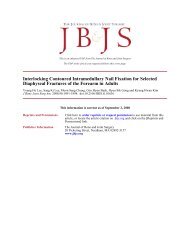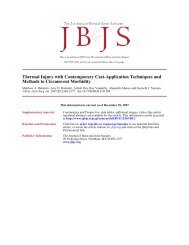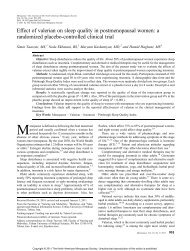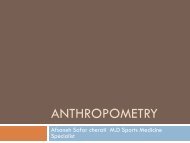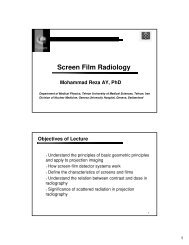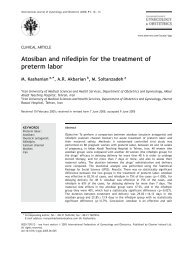Intertrochanteric Fractures: Ten Tips to Improve Results
Intertrochanteric Fractures: Ten Tips to Improve Results
Intertrochanteric Fractures: Ten Tips to Improve Results
Create successful ePaper yourself
Turn your PDF publications into a flip-book with our unique Google optimized e-Paper software.
George J. Haidukewych<br />
J Bone Joint Surg Am. 2009;91:712-719.<br />
This is an enhanced PDF from The Journal of Bone and Joint Surgery<br />
The PDF of the article you requested follows this cover page.<br />
<strong>Intertrochanteric</strong> <strong>Fractures</strong>: <strong>Ten</strong> <strong>Tips</strong> <strong>to</strong> <strong>Improve</strong> <strong>Results</strong><br />
Reprints and Permissions<br />
Publisher Information<br />
This information is current as of March 15, 2009<br />
Click here <strong>to</strong> order reprints or request permission <strong>to</strong> use material from this<br />
article, or locate the article citation on jbjs.org and click on the [Reprints and<br />
Permissions] link.<br />
The Journal of Bone and Joint Surgery<br />
20 Pickering Street, Needham, MA 02492-3157<br />
www.jbjs.org
Selected<br />
Instructional<br />
Course Lectures<br />
The American Academy of Orthopaedic Surgeons<br />
FREDERICK M. AZAR<br />
EDITOR, VOL. 59<br />
COMMITTEE<br />
FREDERICK M. AZAR<br />
CHAIRMAN<br />
PAUL J. DUWELIUS<br />
KENNETH A. EGOL<br />
MARY I. O’CONNOR<br />
PAUL TORNETTA III<br />
EX-OFFICIO<br />
DEMPSEY S. SPRINGFIELD<br />
DEPUTY EDITOR OF THE JOURNAL OF BONE AND JOINT SURGERY<br />
FOR INSTRUCTIONAL COURSE LECTURES<br />
JAMES D. HECKMAN<br />
EDITOR-IN-CHIEF,<br />
THE JOURNAL OF BONE AND JOINT SURGERY<br />
Printed with permission of the American Academy of<br />
Orthopaedic Surgeons. This article, as well as other lectures<br />
presented at the Academy’s Annual Meeting, will be available<br />
in February 2010 in Instructional Course Lectures, Volume 59.<br />
The complete volume can be ordered online at www.aaos.org,<br />
or by calling 800-626-6726 (8 A.M.-5 P.M., Central time).<br />
711
d T HE J OURNAL OF B ONE &JOINT S URGERY JBJS. ORG<br />
d d VOLUME 91-A N UMBER 3 M ARCH 2009<br />
<strong>Intertrochanteric</strong> fractures are becoming<br />
increasingly common as our population<br />
ages. These fractures typically<br />
occur in frail patients with multiple<br />
medical comorbidities and often result<br />
in the end of the patient’s functional<br />
independence. The all-<strong>to</strong>o-often problematic<br />
dispositions and prolonged<br />
hospital stays result in a tremendous<br />
cost <strong>to</strong> patients, their families, and<br />
society. Effective treatment strategies<br />
that result in high rates of union of these<br />
fractures and low rates of complications<br />
are important. As orthopaedic surgeons,<br />
we cannot control the quality of the<br />
bone, patient compliance, or comorbidities,<br />
but we should be able <strong>to</strong><br />
minimize the morbidity associated with<br />
the fracture. This requires choosing the<br />
appropriate fixation device for the<br />
fracture pattern, recognizing the problem<br />
fracture patterns, and performing<br />
accurate reductions with ideal implant<br />
placement while being conscious of<br />
implant costs. If we treat these fractures<br />
expeditiously, minimize fixation failures,<br />
and recognize underlying osteoporosis<br />
and treat it accordingly, we will<br />
improve our patients’ outcomes and<br />
<strong>Intertrochanteric</strong> <strong>Fractures</strong>:<br />
<strong>Ten</strong> <strong>Tips</strong> <strong>to</strong> <strong>Improve</strong> <strong>Results</strong><br />
By George J. Haidukewych, MD<br />
An Instructional Course Lecture, American Academy of Orthopaedic Surgeons<br />
minimize the cost of treating them. The<br />
purpose of this review is <strong>to</strong> summarize<br />
ten simple tips <strong>to</strong> help minimize failures<br />
and improve outcomes when treating<br />
intertrochanteric fractures of the hip.<br />
Tip 1: Use the Tip-<strong>to</strong>-Apex Distance<br />
The tip-<strong>to</strong>-apex distance has been described<br />
by Baumgaertner et al. 1,2 as a<br />
useful intraoperative indica<strong>to</strong>r of deep<br />
and central placement of the lag screw<br />
in the femoral head, regardless of<br />
whether a nail or a plate is chosen <strong>to</strong> fix<br />
the fracture (Fig. 1). This is perhaps the<br />
most important measurement of accurate<br />
hardware placement and has been<br />
shown in multiple studies <strong>to</strong> be predictive<br />
of success after the treatment of<br />
standard obliquity intertrochanteric<br />
fractures. Older theories about screw<br />
placement favored a low and occasionally<br />
a posterior position of the lag screw,<br />
thereby leaving more bone superior and<br />
anterior <strong>to</strong> the screw. This effectively<br />
lengthens the tip-<strong>to</strong>-apex distance and<br />
should be avoided. The ideal position<br />
for a lag screw in both planes is deep<br />
and central in the femoral head within<br />
10 mm of the subchondral bone (Fig.<br />
2) 3,4 . A tip-<strong>to</strong>-apex distance of
d T HE J OURNAL OF B ONE &JOINT S URGERY JBJS. ORG<br />
d d VOLUME 91-A N UMBER 3 M ARCH 2009<br />
Fig. 1<br />
Technique for calculating the tip-<strong>to</strong>-apex distance (TAD). For clarity, a<br />
peripherally placed screw is depicted in the anteroposterior (ap) view<br />
and a shallowly placed screw is depicted in the lateral (lat) view. Dtrue =<br />
known diameter of the lag screw. (Reprinted from: Baumgaertner MR,<br />
Curtin SL, Lindskog DM, Keggi JM. The value of the tip-apex distance in<br />
predicting failure of fixation of peritrochanteric fractures of the hip.<br />
J Bone Joint Surg Am. 1995;77:1059.)<br />
Medoff device) are reported <strong>to</strong> have<br />
reasonably good results, I adhere <strong>to</strong> the<br />
belief that if there is no lateral wall a hip<br />
screw should not be used 3-9 . Locking<br />
713<br />
I NTERTROCHANTERIC F RACTURES:<br />
T EN T IPS TO I MPROVE R ESULTS<br />
plates and 95° condylar blade-plates<br />
may function as prosthetic lateral cortices,<br />
but the results of using these<br />
devices for more problematic fractures<br />
of the proximal part of the femur are<br />
not available 9-11 . Intramedullary nails<br />
seem <strong>to</strong> be superior <strong>to</strong> dynamic condylar<br />
screws for reverse obliquity fractures,<br />
but I am not aware of any<br />
comparative study of intramedullary<br />
nails and proximal femoral locking<br />
plates.<br />
Tip 3: Know the Unstable<br />
<strong>Intertrochanteric</strong> Fracture<br />
Patterns, and Nail Them<br />
There are four classic intertrochanteric<br />
fracture patterns that signify instability.<br />
When internally fixed, the osseous<br />
fragments of these unstable fractures are<br />
not able <strong>to</strong> share the weight-bearing<br />
loads, and therefore the loads are predominantly<br />
borne by the internal fixation<br />
device. The unstable patterns<br />
include reverse obliquity fractures,<br />
transtrochanteric fractures, fractures<br />
with a large posteromedial fragment<br />
implying loss of the calcar buttress, and<br />
fractures with subtrochanteric extension<br />
(Figs. 4 through 7) 3-5,9,12-16 . These<br />
fractures, in general, should be treated<br />
with an intramedullary nail because of<br />
the more favorable biomechanical<br />
Fig. 2 Fig. 3<br />
Fig. 2 Excellent reduction and deep, central placement of the lag screw in the femoral head. Fig. 3 Failed fixation of a reverse obliquity<br />
fracture with lateralization of the proximal fragment and screw cu<strong>to</strong>ut.
d T HE J OURNAL OF B ONE &JOINT S URGERY JBJS. ORG<br />
d d VOLUME 91-A N UMBER 3 M ARCH 2009<br />
Fig. 4 Fig. 5<br />
Fig. 4 A reverse obliquity fracture. Fig. 5 A transtrochanteric fracture.<br />
properties of an intramedullary nail<br />
compared with a sliding hip screw. An<br />
intramedullary nail is located closer <strong>to</strong><br />
the center of gravity than is a sliding hip<br />
714<br />
I NTERTROCHANTERIC F RACTURES:<br />
T EN T IPS TO I MPROVE R ESULTS<br />
screw, and therefore the lever arm on<br />
the femoral fixation is shorter. Intramedullary<br />
nails can more reliably resist<br />
the relatively high forces across the<br />
medial calcar that are typically borne by<br />
the implant in an unstable fracture. The<br />
intramedullary position of the implant<br />
also prevents shaft medialization, which<br />
Fig. 6 Fig. 7<br />
Fig. 6 A four-part fracture with a large posteromedial fragment. Fig. 7 A fracture with subtrochanteric extension.
d T HE J OURNAL OF B ONE &JOINT S URGERY JBJS. ORG<br />
d d VOLUME 91-A N UMBER 3 M ARCH 2009<br />
Fig. 8<br />
A straight nail inserted in<strong>to</strong> a bowed femur. Vigorous<br />
impaction or a bow mismatch may lead <strong>to</strong> perforation<br />
of the distal anterior femoral cortex.<br />
is a common complication associated<br />
with the transtrochanteric and reverse<br />
obliquity fracture patterns. Recognizing<br />
the unstable patterns preoperatively and<br />
choosing <strong>to</strong> use an intramedullary nail<br />
decrease the risk of fixation failure. A<br />
simple fracture of the lesser trochanter<br />
does not, in itself, au<strong>to</strong>matically imply<br />
an unstable fracture, as many three-part<br />
and four-part fractures can include a<br />
small, relatively unimportant fracture of<br />
the lesser trochanter and yet have a<br />
primary fracture line that will <strong>to</strong>lerate<br />
compression well. It is not known<br />
how large the posteromedial fragment<br />
must be <strong>to</strong> be mechanically important.<br />
When there is doubt about the status<br />
of the calcar, however, an intramedullary<br />
nail is preferable <strong>to</strong> a sliding hip<br />
screw.<br />
Tip 4: Beware of the Anterior Bow<br />
of the Femoral Shaft<br />
As a person ages, the femoral diaphysis<br />
enlarges and the femoral bow increases<br />
17 . Most commercial intramedullary<br />
nails have gradually evolved in<strong>to</strong> a<br />
more bowed design, and many of them<br />
now have a radius of curvature of
d T HE J OURNAL OF B ONE &JOINT S URGERY JBJS. ORG<br />
d d VOLUME 91-A N UMBER 3 M ARCH 2009<br />
Fig. 9 Fig. 10<br />
Fig. 9 The ideal starting point is slightly medial <strong>to</strong> the exact tip of the greater trochanter. Note the good position of the guidewire distally.<br />
Fig. 10 An unreduced fracture will not reduce with nail passage because of the capacious metaphysis in most patients with osteopenia.<br />
be difficult in obese patients. Even if<br />
care was taken with the starting point<br />
and the subsequent reaming, if the<br />
intramedullary nail is inserted at an<br />
oblique angle, the nail itself can impact<br />
the relatively soft bone of the lateral<br />
aspect of the greater trochanter and lead<br />
<strong>to</strong> a relatively oval entry point and a<br />
lateral position of the intramedullary<br />
Fig. 11 Fig. 12<br />
Fig. 11 Reduction has been achieved with a clamp placed through a small lateral incision. Fig. 12 Use of a clamp <strong>to</strong> reduce a<br />
fracture with a subtrochanteric extension. Clamps can be inserted without evacuation of the fracture hema<strong>to</strong>ma and with<br />
minimal soft-tissue disruption.<br />
716<br />
I NTERTROCHANTERIC F RACTURES:<br />
T EN T IPS TO I MPROVE R ESULTS
d T HE J OURNAL OF B ONE &JOINT S URGERY JBJS. ORG<br />
d d VOLUME 91-A N UMBER 3 M ARCH 2009<br />
Fig. 13 Fig. 14<br />
Fig. 13 A well-aligned fracture. Note the central position of the lag screw in the femoral head. Fig. 14 Radiograph<br />
showing the relationship between the tip of the greater trochanter and the center of the femoral head. Normally, this<br />
relationship is coplanar. Here, the proximal fragment is in varus, the starting point is lateral, and the screw is high<br />
in the head.<br />
nail in the proximal fragment. It is<br />
critical that the nail be inserted by hand<br />
with slight rotational motions. A hammer<br />
is not recommended since its use<br />
can lead <strong>to</strong> iatrogenic femoral fracture.<br />
It is safe <strong>to</strong> tap the jig with a mallet for<br />
the final seating, since this is an easy way<br />
<strong>to</strong> fine-tune the final position of the<br />
intramedullary nail. The mallet should<br />
not be used when difficulty is encountered<br />
when inserting the intramedullary<br />
nail by hand. The variety of diameters at<br />
the distal end and valgus angles at the<br />
proximal end of modern intramedullary<br />
nail systems have decreased the frequency<br />
of iatrogenic femoral fractures 19 .<br />
It is still important <strong>to</strong> realize that, if a<br />
hammer is needed <strong>to</strong> advance the nail<br />
(as opposed <strong>to</strong> simply tapping it in a few<br />
final millimeters), there is a problem.<br />
The femoral shaft may need <strong>to</strong> be<br />
reamed further <strong>to</strong> prevent nail incarceration<br />
(this is not uncommon in<br />
younger patients) or there may be<br />
impingement on the anterior femoral<br />
cortex with a mismatch between the<br />
bows of the femur and the intramedul-<br />
717<br />
I NTERTROCHANTERIC F RACTURES:<br />
T EN T IPS TO I MPROVE R ESULTS<br />
lary nail. The cause of the difficulty<br />
should be identified and corrected because<br />
the intramedullary nail should be<br />
passed by hand. I ream the intramedullary<br />
canal <strong>to</strong> a diameter that is 1 mm<br />
larger than the diameter of the selected<br />
intramedullary nail, and I ensure that<br />
the starter reamer has been inserted<br />
<strong>to</strong> the recommended depth. This<br />
prevents the funnel shape of the proximal<br />
nail from impinging on the endosteum<br />
proximally and preventing final<br />
seating.<br />
Tip 8: Avoid Varus Angulation of the<br />
Proximal Fragment—Use the<br />
Relationship Between the Tip of<br />
the Trochanter and the Center<br />
of the Femoral Head<br />
Varus angulation of the proximal fragment<br />
increases the lever arm on the<br />
fixation since it makes the femoral neck<br />
more horizontal and therefore functionally<br />
longer when body weight is<br />
applied. This also results in the femoral<br />
head fixation being placed more superiorly<br />
in the head than is ideal and<br />
increases the risk of the device cutting<br />
out of the femoral head. It can be<br />
difficult <strong>to</strong> determine the appropriate<br />
femoral neck-shaft angle in a patient<br />
with an intertrochanteric fracture.<br />
When using an intramedullary nail for<br />
fixation of an intertrochanteric fracture,<br />
most surgeons choose a nail with a 130°<br />
neck-shaft configuration (Figs. 13 and<br />
14). It is important <strong>to</strong> know the neckshaft<br />
angle of the device that is being<br />
used. One way <strong>to</strong> assess varus or valgus<br />
position during surgery is <strong>to</strong> look at the<br />
relationship between the tip of the<br />
greater trochanter and the center of the<br />
femoral head. These two points should<br />
be coplanar. If the center of the femoral<br />
head is distal <strong>to</strong> the tip of the greater<br />
trochanter, the reduction is in varus. If<br />
the center of the head is proximal <strong>to</strong> the<br />
greater trochanter, the reduction is in<br />
valgus. Preoperative plain radiographs<br />
of the uninjured hip can be used <strong>to</strong><br />
assess the patient’s normal neck-shaft<br />
angle as the two sides are normally<br />
symmetric. Varus and high lag-screw<br />
placement are associated with an in-
d T HE J OURNAL OF B ONE &JOINT S URGERY JBJS. ORG<br />
d d VOLUME 91-A N UMBER 3 M ARCH 2009<br />
Fig. 15 Fig. 16<br />
Fig. 15 A fracture locked in distraction. Note the typical lateral starting point and the high hip-screw placement.<br />
Fig. 16 Distracted fractures in varus can result in high loads on the implant, causing nail fracture, typically through<br />
the aperture for the lag screw.<br />
creased frequency of failure of fixation<br />
with an intramedullary nail and sliding<br />
hip screw 20,21 .<br />
Tip 9: When Nailing, Lock the Nail<br />
Distally if the Fracture Is Axially or<br />
Rotationally Unstable<br />
Most unstable fractures of the proximal<br />
part of the femur require a long intramedullary<br />
nail. If there is any question<br />
about the stability of a fracture, then a<br />
long nail should be chosen and, in<br />
most instances, it should be locked<br />
distally 15,22-24 . Although short nails may<br />
be used for minimally displaced or<br />
nondisplaced fractures or very stable<br />
patterns, they can be associated with a<br />
subsequent fracture in the subtrochanteric<br />
area. Although most modern shortnail<br />
designs have smaller-diameter<br />
locking screws in this high-stress area <strong>to</strong><br />
prevent the fractures that were encountered<br />
with the older, large-diameter<br />
locking-screw designs, it is probably<br />
wise <strong>to</strong> protect the length of the femur<br />
and choose a long nail. Using a long<br />
718<br />
I NTERTROCHANTERIC F RACTURES:<br />
T EN T IPS TO I MPROVE R ESULTS<br />
internal fixation device <strong>to</strong> protect the<br />
entire bone is a common principle for<br />
treating a pathologic fracture of bone<br />
caused by metastatic disease, and I<br />
believe that it is wise <strong>to</strong> consider most<br />
fragility fractures in elderly patients <strong>to</strong><br />
be pathologic fractures; in addition, this<br />
patient population has a propensity for<br />
falls, increasing their risk of subsequent<br />
fractures.<br />
Tip 10: Avoid Fracture Distraction<br />
When Nailing<br />
When nails are used for fractures with a<br />
transverse or reverse oblique configuration,<br />
it is not uncommon for the<br />
fracture <strong>to</strong> be either malrotated or<br />
distracted (Fig. 15). If a fracture is<br />
locked in distraction, osseous contact<br />
that can accept some of the load with<br />
weight-bearing does not occur and the<br />
device must withstand all of the forces<br />
associated with the activities of daily<br />
living. <strong>Fractures</strong> that are internally fixed<br />
in distraction are at risk for nonunion<br />
and eventual hardware failure. The nail<br />
breaks through its weakest point, which<br />
is the large aperture in the nail for the<br />
lag screw (Fig. 16). To eliminate distraction,<br />
the traction on the lower limb<br />
should be released during surgery prior<br />
<strong>to</strong> insertion of the distal locking screws<br />
and fluoroscopy should be used <strong>to</strong><br />
confirm that there is bone-on-bone<br />
contact.<br />
Recent Trends<br />
Intramedullary nail fixation has become<br />
more common, even for fractures that<br />
are stable or nondisplaced 25 . Intramedullary<br />
nails should probably not be used<br />
for these simpler types of fractures, and<br />
it is probably better <strong>to</strong> choose sliding<br />
hip screws for relatively simple patterns<br />
and basicervical patterns. Fixation of a<br />
stable or minimally displaced fracture<br />
with a sliding hip screw is acceptable,<br />
and the complication rate and costs are<br />
less. Meta-analyses have demonstrated<br />
that the rates of iatrogenic fracture with<br />
>intramedullary nailing have improved<br />
over time, and the risk of femoral shaft
d T HE J OURNAL OF B ONE &JOINT S URGERY JBJS. ORG<br />
d d VOLUME 91-A N UMBER 3 M ARCH 2009<br />
fracture with nail insertion has decreased<br />
dramatically 19 . This is probably<br />
a reflection of the use of modern<br />
intramedullary nails with smaller diameters,<br />
smaller-diameter locking<br />
screws, and less acute proximal valgus<br />
angles of the proximal nail as well as the<br />
realization that aggressive impaction<br />
1. Baumgaertner MR, Curtin SL, Lindskog DM, Keggi<br />
JM. The value of the tip-apex distance in predicting<br />
failure of fixation of peritrochanteric fractures of the<br />
hip. J Bone Joint Surg Am. 1995;77:1058-64.<br />
2. Baumgaertner MR, Solberg BD. Awareness of tipapex<br />
distance reduces failure of fixation of trochanteric<br />
fractures of the hip. J Bone Joint Surg Br.<br />
1997;79:969-71.<br />
3. Kyle RF, Cabanela ME, Russell TA, Swiontkowski<br />
MF, Winquist RA, Zuckerman JD, Schmidt AH, Koval<br />
KJ. <strong>Fractures</strong> of the proximal part of the femur. Instr<br />
Course Lect. 1995;44:227-53.<br />
4. Kyle RF, Gustilo RB, Premer RF. Analysis of six<br />
hundred and twenty-two intertrochanteric hip fractures.<br />
J Bone Joint Surg Am. 1979;61:216-21.<br />
5. Haidukewych GJ, Israel TA, Berry DJ. Reverse<br />
obliquity fractures of the intertrochanteric region of<br />
the femur. J Bone Joint Surg Am. 2001;83:643-50.<br />
6. Janzing HM, Houben BJ, Brandt SE, Chhoeurn V,<br />
Lefever S, Broos P, Reynders P, Vanderschot P. The<br />
Gotfried PerCutaneous Compression Plate versus the<br />
Dynamic Hip Screw in the treatment of pertrochanteric<br />
hip fractures: minimal invasive treatment<br />
reduces operative time and pos<strong>to</strong>perative pain.<br />
J Trauma. 2002;52:293-8.<br />
7. Knight WM, DeLee JC. Nonunion of intertrochanteric<br />
fractures of the hip: a case study and review<br />
[abstract]. Orthop Trans. 1982;6:438.<br />
8. Kosygan KP, Mohan R, Newman RJ. The Gotfried<br />
percutaneous compression plate compared with the<br />
conventional classic hip screw for the fixation of<br />
intertrochanteric fractures of the hip. J Bone Joint<br />
Surg Br. 2002;84:19-22.<br />
9. Sadowski C, Lübbeke A, Saudan M, Riand N,<br />
Stern R, Hoffmeyer P. Treatment of reverse oblique<br />
719<br />
should be avoided in the nailing of these<br />
fractures.<br />
George J. Haidukewych, MD<br />
Florida Orthopaedic Institute, 13020 Telecom<br />
Parkway, Temple Terrace, FL 33637.<br />
E-mail address: DocGJH@aol.com<br />
References<br />
I NTERTROCHANTERIC F RACTURES:<br />
T EN T IPS TO I MPROVE R ESULTS<br />
and transverse intertrochanteric fractures with use<br />
of an intramedullary nail or a 95° screw-plate: a<br />
prospective, randomized study. J Bone Joint Surg Am.<br />
2002;84:372-81.<br />
10. Kinast C, Bolhofner BR, Mast JW, Ganz R.<br />
Subtrochanteric fractures of the femur. <strong>Results</strong><br />
of treatment with the 95 degrees condylar<br />
blade-plate. Clin Orthop Relat Res. 1989;238:<br />
122-30.<br />
11. Sanders R, Regazzoni P. Treatment of subtrochanteric<br />
femur fractures using the dynamic condylar<br />
screw. J Orthop Trauma. 1989;3:206-13.<br />
12. Haidukewych GJ, Berry DJ. Hip arthroplasty<br />
for salvage of failed treatment of intertrochanteric<br />
hip fractures. J Bone Joint Surg Am. 2003;85:<br />
899-904.<br />
13. Haidukewych GJ, Berry DJ. Salvage of failed<br />
internal fixation of intertrochanteric hip fractures. Clin<br />
Orthop Relat Res. 2003;412:184-8.<br />
14. Koval KJ, Sala DA, Kummer FJ, Zuckerman JD.<br />
Pos<strong>to</strong>perative weight-bearing after a fracture of the<br />
femoral neck or an intertrochanteric fracture. J Bone<br />
Joint Surg Am. 1998;80:352-6.<br />
15. van Doorn R, Stapert JW. The long gamma nail in<br />
the treatment of 329 subtrochanteric fractures with<br />
major extension in<strong>to</strong> the femoral shaft. Eur J Surg.<br />
2000;166:240-6.<br />
16. Wu CC, Shih CH, Chen WJ, Tai CL. Treatment of<br />
cu<strong>to</strong>ut of a lag screw of a dynamic hip screw in an<br />
intertrochanteric fracture. Arch Orthop Trauma Surg.<br />
1998;117:193-6.<br />
17. Ostrum RF, Levy MS. Penetration of the distal<br />
femoral anterior cortex during intramedullary nailing<br />
for subtrochanteric fractures: a report of three cases.<br />
J Orthop Trauma. 2005;19:656-60.<br />
Printed with permission of the American<br />
Academy of Orthopaedic Surgeons. This<br />
article, as well as other lectures presented at<br />
the Academy’s Annual Meeting, will be<br />
available in March 2010 in Instructional<br />
Course Lectures, Volume 59. The complete<br />
volume can be ordered online at<br />
www.aaos.org, or by calling 800-626-6726<br />
(8 A.M.-5 P.M., Central time).<br />
18. Ostrum RF, Marcan<strong>to</strong>nio A, Marburger R. A<br />
critical analysis of the eccentric starting point for<br />
trochanteric intramedullary femoral nailing. J Orthop<br />
Trauma. 2005;19:681-6.<br />
19. Bhandari M, Joensson A, Schemitsch E,<br />
Haidukewych G. Gamma nails revisited: gamma<br />
nails versus compression hip screws in the management<br />
of intertrochanteric fractures of the hip:<br />
a meta-analysis. J Orthop Trauma. In press.<br />
20. Lindskog DM, Baumgaertner MR. Unstable intertrochanteric<br />
hip fractures in the elderly. J Am Acad<br />
Orthop Surg. 2004;12:179-90.<br />
21. Shukla S, Johns<strong>to</strong>n P, Ahmad MA, Wynn-Jones<br />
H, Patel AD, Wal<strong>to</strong>n NP. Outcome of traumatic<br />
subtrochanteric femoral fractures fixed using<br />
cephalo-medullary nails. Injury. 2007;38:<br />
1286-93.<br />
22. Adams CI, Robinson CM, Court-Brown CM,<br />
McQueen MM. Prospective randomized controlled<br />
trial of an intramedullary nail versus dynamic screw<br />
and plate for intertrochanteric fractures of the femur.<br />
J Orthop Trauma. 2001;15:394-400.<br />
23. Barquet A, Francescoli L, Rienzi D, López L.<br />
<strong>Intertrochanteric</strong>-subtrochanteric fractures: treatment<br />
with the long Gamma nail. J Orthop Trauma.<br />
2000;14:324-8.<br />
24. Parker MJ, Pryor GA. Gamma versus DHS nailing<br />
for extracapsular femoral fractures. Meta-analysis of<br />
ten randomised trials. Int Orthop. 1996;20:163-8.<br />
25. Anglen JO, Weinstein JN; American Board of<br />
Orthopaedic Surgery Research Committee. Nail or<br />
plate fixation of intertrochanteric hip fractures:<br />
changing pattern of practice. A review of the American<br />
Board of Orthopaedic Surgery database. J Bone<br />
Joint Surg Am. 2008;90:700-7.



